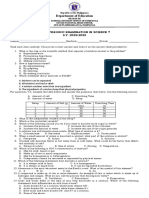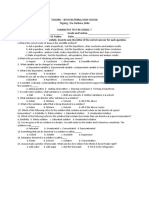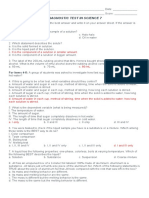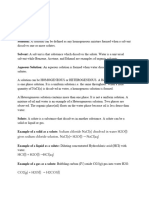1ST Summative Science7
1ST Summative Science7
Uploaded by
Mae CudalCopyright:
Available Formats
1ST Summative Science7
1ST Summative Science7
Uploaded by
Mae CudalOriginal Title
Copyright
Available Formats
Share this document
Did you find this document useful?
Is this content inappropriate?
Copyright:
Available Formats
1ST Summative Science7
1ST Summative Science7
Uploaded by
Mae CudalCopyright:
Available Formats
Republic of the Philippines
Department of Education
REGION XIII – CARAGA
SCHOOLS DIVISION OF BUTUAN CITY
ALVIOLA VILLAGE INTEGRATED SECONDARY SCHOOL – BAAN CAMPUS
BRGY. BAAN KM 3, BUTUAN CITY
SUMMATIVE EXAMINATION #1
SCIENCE 7, QUARTER 1
Name: ____________________________________________ Date: _________________ Score
Teacher: _________________________________________ Grade and Section: _________________________
Instruction: For multiple choice items, encircle the letter of the correct answer. For non-multiple-
choice items, write it on the space provided.
1. What is a systematic process of empirical investigation and the key to unlock the bodies of
knowledge by helping the researcher in organizing thoughts and procedures?
a. scientific method b. conclusion c. hypothesis d. experimentation
2. What is the first step in the scientific method?
a. collect and analyze data c. state the problem to be investigated
b. conduct the experiment d. draw a conclusion based upon the
observations
3. For an experiment, a scientist put lime at the base of tomato plant A and baking soda at the base
of tomato plant B. She then sealed the plants in plastic bags. Tomato plant A eventually died, and
tomato plant B stayed healthy. What was the dependent variable in this experiment?
a. type of plant grown for the test c. substance at the base of each plant
b. response of the plants to each substance d. plastic bag wrapped around each plant
4. Which of the following is the best high-level scientific question?
a. Who made the first microscope?
b. How many giraffes live in Africa?
c. How long ago did dinosaurs live on Earth?
d. Does the amount of salt in water affect the temperature it boils?
5. Jackson and Mia want to do an experiment to determine how the temperature of water affects how
much salt can be dissolve in it. In what order should they perform the following steps?
Step 1: With a teacher’s help, bring the water in one of the beakers to the boiling point.
Step 2: Pour equal amounts of water into two identical beakers.
Step 3: Record how many half-teaspoons of salt are completely dissolved in each beaker.
Step 4: Gradually put salt into the water of each beaker, half-teaspoon at a time.
a. 4 2 1 3 b. 2 1 4 3 c. 2 4 1 3 d. 1 2 4 3
6. Which of the following hypotheses is written correctly?
a. If frozen tennis balls will not bounce as high.
b. If I heat up a tennis ball it will bounce high.
c. If I freeze a tennis ball, then it will not bounce as high.
d. If a tennis ball is frozen, it will not bounce as high as one that is not frozen.
7.9. Formulate a conclusion based from the data given below.
(A correctly written conclusion must include all of the following: a. Written in complete sentences. b.
Responded as to whether your hypothesis was right or wrong, c. Answered the questions written in the
problem) (3 points – if the conclusion includes all three requirements. 2 points – if the conclusion
included two out of three requirements. 1 point – if the conclusion included one out of three requirements)
Hypothesis: Fertilizers have an effect on the growth of plants. Plants with fertilizers grow bigger.
Setup Initial Height of Frequency of Treatment Given Growth of Plants
Plant Watering for Three Weeks
Group A 15 cm Twice a week 200 mL of plain 18 cm
water
Group B 15 cm Twice a week 200 mL of fertilizer 32 cm
solution
Answer:
________________________________________________________________________________
10. Which of the following statements is TRUE about elements and compounds?
a. Are homogenous in nature c. Are commonly naturally occurring materials
b. Are simplest form of matter d. Can be broken down into simpler
substances
11. Why is it important to be familiar with elements and compounds?
a. To classify them accordingly. c. To enumerate elements and compounds.
b. To tell others you know them. d. To be praised by others of knowing them
12. Which of the following shows set of properties of an element?
a. Made up of big particles of atom. c. Composed of one element with same
properties
b. Joined through chemical process. d. Joined through mechanical process
13. Which of the following is correctly matched compound?
a. Carbon and Oxygen (Carbon dioxide) c. Hydrogen and Water (Hydrogen dioxide)
b. Sodium and Chlorine (Sodium chloride) d. Potassium and Nitrogen (Potassium nitrite)
14. Carbon dioxide, sodium chloride, sugar and salt are examples of ________________.
a. Compounds b. Elements c. Ingredients d. Nutrition facts
15. Which of the following will be the result of compound if Hydrogen gas and oxygen gas combine?
a. Alcohol b. Salt c. Sugar d. Water
16. The following are constituent elements of sodium glutamate, EXCEPT
a. Carbon b. Hydrogen c. Iron d. Sodium
17. Which element is NOT found in the chocolate candy?
a. Calcium b. Hydrogen c. Iron d. Sodium
18. Sodium is a silvery solid that reacts violently with water and chlorine. When they combine to form
the compound sodium chloride known as salt, there is a fundamental change in the properties.
Salt is often added to our food when cooking and it is safe to eat. Which of the following
statements supports the idea presented?
a. True to all compounds, they no longer have the properties of elements that make them up.
b. True to some compounds, it maintains the properties of the elements that make them up.
c. True in all elements, it maintains its properties even after it combines with other elements.
d. True to all elements, they have the properties after they are combined.
For items 19-21:
Directions: Look on the food label of soy sauce below. Then, complete the table by giving at least
one compound and two or more of its constituent elements.
NUTRITION FACTS AND INGREDIENTS
Compound Constituent Elements
20. ________________________
19. ______________________________ 21. ________________________________
22. What are the two (2) classes of matter?
a. Atom and molecule C. Plant and animal cells
b. Element and compound D. Substance and mixture
23. Which of the following is a heterogeneous mixture?
a. Air b. Oil in water c. Stainless steel d. Soft drink
24. What is the difference between a substance and a mixture?
a. Substance can be separated while mixture cannot be separated.
b. Substance has many components while mixture has one only.
c. Substance is heterogeneous while mixture is homogeneous.
d. Substance is pure while mixture is impure.
25. What is the best way to use in separating iron fillings from a mixture?
a. Filter paper b. Magnet c. Water d. Spoon
26. A gaseous material has a strong smell, evaporates quickly, particularly boils at -33.34˚C and melts
at -77.73˚C. This matter can be classified as ________.
a. metal b. mixture c. solution d. substance
27. Sodium chloride (Salt) dissolves in water very well. Which is NOT TRUE in the following
statements?
a. Water is a pure substance.
b. Sodium chloride is a pure substance.
c. Dissolving sodium chloride with water produces a mixture.
d. Dissolving sodium chloride with water produces a new substance.
28. Which of the following uses evaporation as a means of separating components of the mixture?
a. Oil and water c. Pebbles and sand
b. Sand and gravel d. Salt and water
29. Water boils at 100˚C & pure ethanol at 78˚C. Which of the statements are TRUE about water &
ethanol?
I. Water and ethanol are pure substances.
II. Water and ethanol can be boiled at either 100˚C or 78˚C.
III. Water and ethanol have specific temperatures at which they would start to boil.
IV. Water and ethanol can be identified according to temperature at which they boil.
a. I only b. I, II and IV c. III only d. I, III, and IV
30. Glenn wants to separate salt and water mixture. Which of the following will help him to
successfully separate the components of the mixture?
I. Using a magnet II. Decantation III. Dissolving IV. Evaporation
a. I, II, III, IV b. I, II c. III, IV d. IV only
_________________________________________
Parent’s Name and Signature with Date
You might also like
- Selection, Design, and Installation of Dimension Stone Attachment SystemsDocument23 pagesSelection, Design, and Installation of Dimension Stone Attachment Systemsศุภณัฐ ชื่นใจดีNo ratings yet
- 1st Quarter Summative Test Science 7Document18 pages1st Quarter Summative Test Science 7she83% (18)
- TQ - Science 7 (2nd) - ReviewerDocument3 pagesTQ - Science 7 (2nd) - ReviewerLouie Jane Eleccion50% (2)
- Summative Test 1Document2 pagesSummative Test 1Santisas Zai100% (6)
- 1st Quarter Exam S.y.2018-2019Document19 pages1st Quarter Exam S.y.2018-2019Ruby Rose Reambonanza MagsolingNo ratings yet
- G7 Periodical TestDocument3 pagesG7 Periodical TestEmieleah Lorenzo PauigNo ratings yet
- Grade 7 Science Unified Test 1 QuarterDocument6 pagesGrade 7 Science Unified Test 1 QuarterMichael Deliva100% (2)
- First Quarter ExaminationDocument3 pagesFirst Quarter ExaminationLo ViNo ratings yet
- Science 7 - Summative Test 1st QuarterDocument4 pagesScience 7 - Summative Test 1st QuarterEsther Mae Ann Trugillo50% (2)
- Summative-Sci7-1st QuarterDocument3 pagesSummative-Sci7-1st QuarterRav De Venecia100% (1)
- Science 7 First Periodic Examination 2022 2023Document3 pagesScience 7 First Periodic Examination 2022 2023Sheena Acayan100% (1)
- 1st PERIODICAL IN SCIENCE 7 2019 - 2020Document8 pages1st PERIODICAL IN SCIENCE 7 2019 - 2020Belinda LapsitNo ratings yet
- 1st Periodic Test - Science 7Document4 pages1st Periodic Test - Science 7Montealegre Nhet100% (2)
- 1st Periodic Test - Science 7Document4 pages1st Periodic Test - Science 7Joan Alfaras75% (4)
- Answer Key Science 7 - 1ST Monthly TestDocument1 pageAnswer Key Science 7 - 1ST Monthly TestMaria Jocosa100% (2)
- 1st Periodic Test - Science 7Document4 pages1st Periodic Test - Science 7laarni malata100% (1)
- First Summative Test in Science 7Document5 pagesFirst Summative Test in Science 7Monica P. RamosNo ratings yet
- Second Periodical Test - For ReDocument4 pagesSecond Periodical Test - For ReJessica Manawes Navor100% (1)
- S T I S: Itio Arget Ntegrated ChoolDocument4 pagesS T I S: Itio Arget Ntegrated Chooljam syNo ratings yet
- Summative Science 7-2ndquarterDocument3 pagesSummative Science 7-2ndquarterNinel Jean Cantera Buniel100% (1)
- Second Periodical Test in Science 7Document3 pagesSecond Periodical Test in Science 7tolis100% (1)
- Science 7 1st Quarter ExamDocument2 pagesScience 7 1st Quarter ExamLeslie Quingco100% (3)
- DIVTESTSCIG71STQUARTERDocument7 pagesDIVTESTSCIG71STQUARTERBoyeth RulidaNo ratings yet
- Science 7 First Quarter - 1st Summative TestDocument3 pagesScience 7 First Quarter - 1st Summative TestWillyn Grace Sacasac Pacanos100% (2)
- Second Periodical Test in ScienceDocument2 pagesSecond Periodical Test in ScienceLorraine lee100% (1)
- Science 7-LONG QUIZ 4Document4 pagesScience 7-LONG QUIZ 4Filii ZamorensisNo ratings yet
- WORKSHEET 1 - Science 7 - Second Quarter - Topic 1 - MicrosDocument3 pagesWORKSHEET 1 - Science 7 - Second Quarter - Topic 1 - MicrosMary Shaynah Jungwirth100% (3)
- Science 7 - 1ST Monthly TestDocument3 pagesScience 7 - 1ST Monthly TestMaria Jocosa100% (2)
- Summative Test 1.3Document1 pageSummative Test 1.3Santisas Zai100% (1)
- First Quarter Test in Science 7Document5 pagesFirst Quarter Test in Science 7noemiNo ratings yet
- Q1 - Science7 - Summative4 (SY 2020-2021)Document3 pagesQ1 - Science7 - Summative4 (SY 2020-2021)Louie Jane EleccionNo ratings yet
- Grade 7 Science Examination Second Quarter 17ldbkgDocument4 pagesGrade 7 Science Examination Second Quarter 17ldbkgMuffy MirandaNo ratings yet
- Validation 2 Quarter 2 Science 7Document4 pagesValidation 2 Quarter 2 Science 7Dwayne GreyNo ratings yet
- First Periodical Examination For GRADE 7 SCIENCEDocument2 pagesFirst Periodical Examination For GRADE 7 SCIENCEMyrson MalayanNo ratings yet
- Science 7 First QuarterDocument5 pagesScience 7 First QuarterWillyn Grace Sacasac PacanosNo ratings yet
- Summative Test in Science 7 Week 1 & 2Document5 pagesSummative Test in Science 7 Week 1 & 2Esther Mae Ann TrugilloNo ratings yet
- TQ Science 7 1st GradingDocument4 pagesTQ Science 7 1st GradingRocaya SaripNo ratings yet
- Quiz Levels of Biological OrganizationDocument2 pagesQuiz Levels of Biological OrganizationCheMaeNicolGile100% (1)
- Summative Test in Science 7Document2 pagesSummative Test in Science 7John Perseus Lee100% (1)
- Science and Technology 7Document4 pagesScience and Technology 7ANDJELYN M. ABALOSNo ratings yet
- 1st-Periodical-Test-SCIENCE-6 WT Levels of UnderstandingDocument6 pages1st-Periodical-Test-SCIENCE-6 WT Levels of UnderstandingDanski Pomilar100% (3)
- LONG TEST IN TLE 7 (Fourth Quarter)Document1 pageLONG TEST IN TLE 7 (Fourth Quarter)Jeo MillanoNo ratings yet
- Grade 7 Final AssessmentDocument5 pagesGrade 7 Final AssessmentMary Joy TibayNo ratings yet
- 1st Periodic Test in ScienceDocument2 pages1st Periodic Test in Sciencecrisel100% (1)
- Science 7 1st Quarter TestDocument4 pagesScience 7 1st Quarter TestUriah BoholstNo ratings yet
- Science 7Document4 pagesScience 7James Lacuesta Tabiolo25% (4)
- Summative Test Science 7Document1 pageSummative Test Science 7Montealegre NhetNo ratings yet
- Esp 2ND QuarterDocument2 pagesEsp 2ND QuarterJenny Mae MajesterioNo ratings yet
- 3RD sUMMATIVE 2Q-Science 7Document2 pages3RD sUMMATIVE 2Q-Science 7Melannie Magalong100% (1)
- LE Science7 Q1 Week-1 FinalDocument21 pagesLE Science7 Q1 Week-1 FinalGemma Puracan100% (1)
- Science: Third Quarter - Module 6 Heat TransferDocument42 pagesScience: Third Quarter - Module 6 Heat TransferJonnah Faye Mojares100% (1)
- 4th Quarter ExamDocument10 pages4th Quarter ExamBryan de VeraNo ratings yet
- 1st Peridoical Test G7Document3 pages1st Peridoical Test G7Jane Limsan Paglinawan100% (1)
- DLL Science Quarter 1 Week 3Document4 pagesDLL Science Quarter 1 Week 3Vincent O GadianNo ratings yet
- First Quarter Test in Grade 7 Scienc1Document3 pagesFirst Quarter Test in Grade 7 Scienc1Revtech Revalbos100% (1)
- Group 1 Lesson Plan 2 SolutionsDocument4 pagesGroup 1 Lesson Plan 2 SolutionsSheila Marie Bangco100% (1)
- Mapeh 7 1Q Examination Answer KeyDocument1 pageMapeh 7 1Q Examination Answer KeyJohn Michael Vincent Adriatico100% (1)
- Learning Activity Sheet: Science 7Document5 pagesLearning Activity Sheet: Science 7malouNo ratings yet
- 1ST Periodical TestDocument4 pages1ST Periodical TestSheryl R. Valiente100% (1)
- Science 7 First Quarter ExamDocument8 pagesScience 7 First Quarter ExamBhell amc1797No ratings yet
- Scie7 Diagnostic TestDocument6 pagesScie7 Diagnostic TestEnrick PestilosNo ratings yet
- Final Summative Exam #2 Grade 7Document4 pagesFinal Summative Exam #2 Grade 7Mae CudalNo ratings yet
- Department of Education: Individual Workweek Accomplishment ReportDocument2 pagesDepartment of Education: Individual Workweek Accomplishment ReportMae CudalNo ratings yet
- Department of Education: Individual Workweek Accomplishment ReportDocument2 pagesDepartment of Education: Individual Workweek Accomplishment ReportMae CudalNo ratings yet
- Department of Education: Individual Workweek Accomplishment ReportDocument9 pagesDepartment of Education: Individual Workweek Accomplishment ReportMae CudalNo ratings yet
- Instruction: Shade The Letter of The Correct Answer On The Answer Sheet Provided. Do Not Write Anything On This Test QuestionnaireDocument2 pagesInstruction: Shade The Letter of The Correct Answer On The Answer Sheet Provided. Do Not Write Anything On This Test QuestionnaireMae CudalNo ratings yet
- Department of Education: Individual Workweek Accomplishment ReportDocument5 pagesDepartment of Education: Individual Workweek Accomplishment ReportMae CudalNo ratings yet
- Science Summative Exam2Document3 pagesScience Summative Exam2Mae CudalNo ratings yet
- Health7 - Summative Exam2Document1 pageHealth7 - Summative Exam2Mae CudalNo ratings yet
- Instruction: Shade The Letter of The Correct Answer On The Answer Sheet Provided. Do Not Write Anything On This Test QuestionnaireDocument3 pagesInstruction: Shade The Letter of The Correct Answer On The Answer Sheet Provided. Do Not Write Anything On This Test QuestionnaireMae CudalNo ratings yet
- Instruction: Shade The Letter of The Correct Answer On The Answer Sheet Provided. Do Not Write Anything On This Test QuestionnaireDocument1 pageInstruction: Shade The Letter of The Correct Answer On The Answer Sheet Provided. Do Not Write Anything On This Test QuestionnaireMae CudalNo ratings yet
- Department of Education: Republic of The PhilippinesDocument4 pagesDepartment of Education: Republic of The PhilippinesMae CudalNo ratings yet
- Reflection On Module 1Document1 pageReflection On Module 1Mae CudalNo ratings yet
- Forgings For Low Temperature ApplicationsDocument1 pageForgings For Low Temperature ApplicationsTasmanijskaNemaNo ratings yet
- Separation TechniquesDocument27 pagesSeparation Techniquescarresha applewhaiteNo ratings yet
- Anaerobic Azo Dye ReductionDocument154 pagesAnaerobic Azo Dye ReductionrajdewaanNo ratings yet
- 1976 Changes in Fecal Composition and Colonic Function Due To Cereal FiberDocument6 pages1976 Changes in Fecal Composition and Colonic Function Due To Cereal FiberMyriam CardenasNo ratings yet
- Para Consulta: Glass Capillary Kinematic ViscometersDocument25 pagesPara Consulta: Glass Capillary Kinematic ViscometersJUAN CARLOSNo ratings yet
- Basca - IBC Washing MachineDocument2 pagesBasca - IBC Washing Machinefajar wibisonoNo ratings yet
- Laser Shock Forging-A Novel in Situ Method DesignedDocument16 pagesLaser Shock Forging-A Novel in Situ Method DesignedEstefania CovarrubiasNo ratings yet
- L3 Electric PotentialDocument22 pagesL3 Electric PotentialBakhat BaidarNo ratings yet
- Physical: ECE 874: ElectronicsDocument35 pagesPhysical: ECE 874: ElectronicssrikanthdiviNo ratings yet
- Abb Kopex Ex DTS A1 Poster 2018 AwDocument1 pageAbb Kopex Ex DTS A1 Poster 2018 Awmohamed abourayaNo ratings yet
- Icse Class 10 March21 Chemistry Question Paper With Solutions 2023Document23 pagesIcse Class 10 March21 Chemistry Question Paper With Solutions 2023Ankit KumarNo ratings yet
- SS2 Chemistry Solubility Week 3Document6 pagesSS2 Chemistry Solubility Week 3kumoyejoyNo ratings yet
- PTFE HY22 HoerbigerDocument1 pagePTFE HY22 HoerbigerТатьяна ВасильеваNo ratings yet
- Crystallization in Lactose RefiningDocument23 pagesCrystallization in Lactose Refiningruth ventocillaNo ratings yet
- Sp-Eng-004 Rev. 19Document16 pagesSp-Eng-004 Rev. 19fael_fvNo ratings yet
- Associate Scientist Chemistry in San Francisco Bay Resume Bassam DaibesDocument2 pagesAssociate Scientist Chemistry in San Francisco Bay Resume Bassam DaibesBassamDaibesNo ratings yet
- Development of Sediment Transport Equations For SeDocument5 pagesDevelopment of Sediment Transport Equations For SeAndhika SasongkoNo ratings yet
- PROBLEMSDocument8 pagesPROBLEMSPaul Suico100% (1)
- Geometric Geodesy Geometric GeodesyDocument10 pagesGeometric Geodesy Geometric GeodesyKismet100% (1)
- I. P.O. NJDocument15 pagesI. P.O. NJyeenNo ratings yet
- Ultimeg 2001WW - H Single Component Thixotropic Epoxy ResinDocument3 pagesUltimeg 2001WW - H Single Component Thixotropic Epoxy ResinBabyboy2010No ratings yet
- 2011 British Chemistry Olympiad TestDocument8 pages2011 British Chemistry Olympiad TestAndrew ChenNo ratings yet
- 15.calorimetry and Thermal ExpansionExerciseDocument36 pages15.calorimetry and Thermal ExpansionExercisePraveen KumarNo ratings yet
- Dielectrics 2019Document103 pagesDielectrics 2019Varshith Ravikanti75% (4)
- SEM LectureDocument7 pagesSEM Lectureabdul rehman khanNo ratings yet
- Mark Scheme Unit g484 The Newtonian World JanuaryDocument14 pagesMark Scheme Unit g484 The Newtonian World JanuaryFarhad AliNo ratings yet
- Vehicle Cleaning and Care: Raw Materials and Chemical AdditivesDocument17 pagesVehicle Cleaning and Care: Raw Materials and Chemical Additivesedgar.geb5937100% (1)
- The Molarity Calculator EquationDocument5 pagesThe Molarity Calculator EquationRama Anil100% (1)
- Photosynthesis: Questions & AnswersDocument6 pagesPhotosynthesis: Questions & AnswersAakash0% (1)





































































































